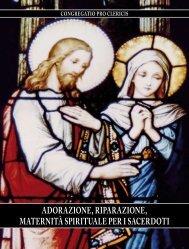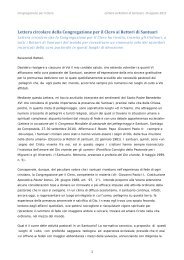La lingua nella liturgia di Rito Romano latino e lingua volgare
La lingua nella liturgia di Rito Romano: latino e lingua volgare
La lingua nella liturgia di Rito Romano: latino e lingua volgare
- No tags were found...
You also want an ePaper? Increase the reach of your titles
YUMPU automatically turns print PDFs into web optimized ePapers that Google loves.
In the <strong>La</strong>tin Rite what has come to be known as the Gregorian Chant has been tra<strong>di</strong>tional. A <strong>di</strong>stinctive liturgical chant existe<strong>di</strong>ndeed in Rome before St Gregory the Great (+604). But it was this great Pontiff who gave it the greatest prominence.After St Gregory this tra<strong>di</strong>tion of chant continued to develop and be enriched until the upheavals that brought an end to the MiddleAges. The monasteries, especially those of the Bene<strong>di</strong>ctine Order, have done much to preserve this heritage.Gregorian Chant is marked by a moving me<strong>di</strong>tative cadence. It touches the depths of the soul. It shows joy, sorrow, repentance,petition, hope, praise or thanksgiving, as the particular feast, part of the Mass or other prayer may in<strong>di</strong>cate. It makes the Psalmscome alive. It has a universal appeal which makes it suitable for all cultures and peoples. It is appreciated in Rome, Solesmes, <strong>La</strong>gos,Toronto and Caracas. Cathedrals, monasteries, seminaries, sanctuaries, pilgrimage centres and tra<strong>di</strong>tional parishes resound with it.St Pope Pius X extolled the Gregorian Chant in 1904 (cf. Tra le Sollecitu<strong>di</strong>ni, n. 3). The Second Vatican Council praised it in 1963:"The Church acknowledges Gregorian Chant as proper to the Roman liturgy: therefore, other things being equal, it should be givenpride of place in liturgical services" (SC, n. 116).The Servant of God, Pope John Paul II, repeated this praise in 2003 (cf. Chirograph for the Centenary of Tra Le Sollecitu<strong>di</strong>ni, nn. 4‐7;in Congregation for Divine Worship and the Discipline of the Sacraments: Spiritus et Sponsa, 2003, p. 130).Pope Bene<strong>di</strong>ct XVI encouraged the International Association of Pueri Cantores when they met in Rome at the end of 2005. Theygive a privileged place to the Gregorian Chant. In Rome and throughout the world the Church is blessed with many fine choirs, bothprofessional and amateur, that render the chant beautifully, and communicate their enthusiasm for it.It is not true that the lay faithful do not want to sing the Gregorian Chant. What they are asking for are priests and monks and nunswho will share this treasure with them.The CDs produced by the Bene<strong>di</strong>ctine monks of Silos, their motherhouse at Solesmes, and numerous other communities sell amongyoung people. Monasteries are visited by people who want to sing <strong>La</strong>uds and especially Vespers.In an or<strong>di</strong>nation ceremony of 11 priests which I celebrated in Nigeria last July, about 150 priests sang the First Eucharistic Prayer in<strong>La</strong>tin. It was beautiful. The people, although no <strong>La</strong>tin scholars, loved it. It should be just normal that parish churches where thereare four or five Masses on Sunday should have one of these Masses sung in <strong>La</strong>tin.5. Did Vatican II <strong>di</strong>scourage <strong>La</strong>tin?Some people think, or have the perception, that the Second Vatican Council <strong>di</strong>scouraged the use of <strong>La</strong>tin in the liturgy. This is notthe case.Just before he opened the Council, Bl. Pope John XXIII in 1962 issued an Apostolic Constitution to insist on the use of <strong>La</strong>tin in theChurch. The Second Vatican Council, although it admitted some introduction of the vernacular, insisted on the place of <strong>La</strong>tin:"Particular law remaining in force, the use of the <strong>La</strong>tin language is to be preserved in the <strong>La</strong>tin rites" (SC, n. 36).The Council also required that seminarians "should acquire a command of <strong>La</strong>tin which will enable them to understand and use thesource material of so many sciences and the documents of the Church as well" (Optatam Totius, n. 13). The Code of Canon <strong>La</strong>wpublished in 1983 enacts that "the Eucharistic celebration is to be carried out either in the <strong>La</strong>tin language or in another language,provided the liturgical texts have been lawfully approved" (can. 928).Those, therefore, who want to give the impression that the Church has put <strong>La</strong>tin away from her liturgy are mistaken. Amanifestation of people's acceptance of <strong>La</strong>tin liturgy well celebrated was had at the world level in April 2005, when millionsfollowed the burial rites of Pope John Paul II and then, two weeks later, the inauguration Mass of Pope Bene<strong>di</strong>ct XVI over thetelevision.It is remarkable that young people welcome the Mass celebrated sometimes in <strong>La</strong>tin. Problems are not lacking. So, too, there aremisunderstan<strong>di</strong>ngs and wrong approaches on the part of some priests on the use of <strong>La</strong>tin. But to get the matter in better focus, it isnecessary first to examine the use of the vernacular in the liturgy of the Roman Rite today.6. The Vernacular: Introduction, Extension, Con<strong>di</strong>tionsThe introduction of local languages into the sacred liturgy of the <strong>La</strong>tin Rite is a development that <strong>di</strong>d not occur all of a sudden. Afterthe partial experience gained over the prece<strong>di</strong>ng years in certain countries, already on 5 and 6 December 1962, after long andsometimes impassioned debates, the Second Vatican Fathers adopted the principle that the use of the mother tongue, whether inthe Mass or other parts of the liturgy, frequently may be of advantage to the people. In the following year the Council voted toapply this principle to the Mass, the ritual and the Liturgy of the Hours (cf. SC, nn. 36, 54, 63a, 76, 78, 101).Extensions of the use of the vernacular followed. But, as if the Council Fathers foresaw the likelihood that <strong>La</strong>tin might lose moreand more ground, they insisted again and again that <strong>La</strong>tin be maintained.








